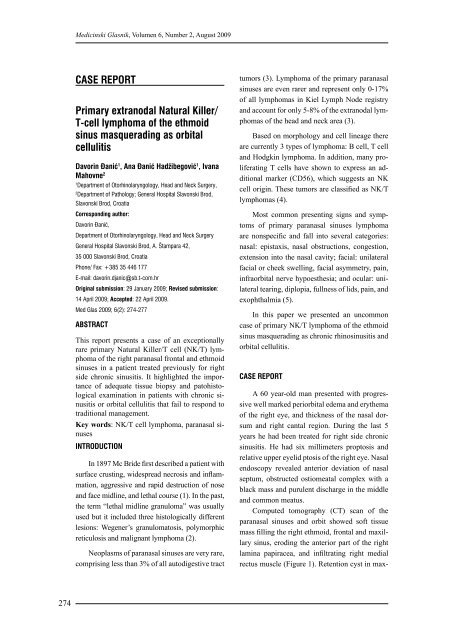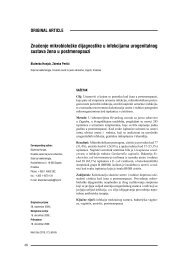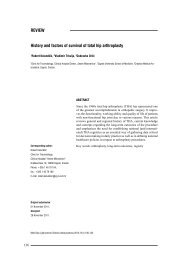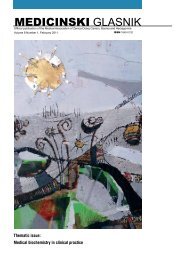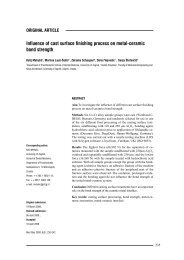MEDICINSKI GLASNIK
MEDICINSKI GLASNIK
MEDICINSKI GLASNIK
You also want an ePaper? Increase the reach of your titles
YUMPU automatically turns print PDFs into web optimized ePapers that Google loves.
274<br />
Medicinski Glasnik, Volumen 6, Number 2, August 2009<br />
CASE REPORT<br />
Primary extranodal Natural Killer/<br />
T-cell lymphoma of the ethmoid<br />
sinus masquerading as orbital<br />
cellulitis<br />
Davorin \anić1 , Ana \anić Hadžibegović1 , Ivana<br />
Mahovne2 1Department of Otorhinolaryngology, Head and Neck Surgery,<br />
2Department of Pathology; General Hospital Slavonski Brod,<br />
Slavonski Brod, Croatia<br />
Corresponding author:<br />
Davorin \anić,<br />
Department of Otorhinolaryngology, Head and Neck Surgery<br />
General Hospital Slavonski Brod, A. Štampara 42,<br />
35 000 Slavonski Brod, Croatia<br />
Phone/ Fax: +385 35 446 177<br />
E-mail: davorin.djanic@sb.t-com.hr<br />
Original submission: 29 January 2009; Revised submission:<br />
14 April 2009; Accepted: 22 April 2009.<br />
Med Glas 2009; 6(2): 274-277<br />
ABSTRACT<br />
This report presents a case of an exceptionally<br />
rare primary Natural Killer/T cell (NK/T) lymphoma<br />
of the right paranasal frontal and ethmoid<br />
sinuses in a patient treated previously for right<br />
side chronic sinusitis. It highlighted the importance<br />
of adequate tissue biopsy and patohistological<br />
examination in patients with chronic sinusitis<br />
or orbital cellulitis that fail to respond to<br />
traditional management.<br />
Key words: NK/T cell lymphoma, paranasal sinuses<br />
INTRODUCTION<br />
In 1897 Mc Bride first described a patient with<br />
surface crusting, widespread necrosis and inflammation,<br />
aggressive and rapid destruction of nose<br />
and face midline, and lethal course (1). In the past,<br />
the term “lethal midline granuloma” was usually<br />
used but it included three histologically different<br />
lesions: Wegener’s granulomatosis, polymorphic<br />
reticulosis and malignant lymphoma (2).<br />
Neoplasms of paranasal sinuses are very rare,<br />
comprising less than 3% of all autodigestive tract<br />
tumors (3). Lymphoma of the primary paranasal<br />
sinuses are even rarer and represent only 0-17%<br />
of all lymphomas in Kiel Lymph Node registry<br />
and account for only 5-8% of the extranodal lymphomas<br />
of the head and neck area (3).<br />
Based on morphology and cell lineage there<br />
are currently 3 types of lymphoma: B cell, T cell<br />
and Hodgkin lymphoma. In addition, many proliferating<br />
T cells have shown to express an additional<br />
marker (CD56), which suggests an NK<br />
cell origin. These tumors are classified as NK/T<br />
lymphomas (4).<br />
Most common presenting signs and symptoms<br />
of primary paranasal sinuses lymphoma<br />
are nonspecific and fall into several categories:<br />
nasal: epistaxis, nasal obstructions, congestion,<br />
extension into the nasal cavity; facial: unilateral<br />
facial or cheek swelling, facial asymmetry, pain,<br />
infraorbital nerve hypoesthesia; and ocular: unilateral<br />
tearing, diplopia, fullness of lids, pain, and<br />
exophthalmia (5).<br />
In this paper we presented an uncommon<br />
case of primary NK/T lymphoma of the ethmoid<br />
sinus masquerading as chronic rhinosinusitis and<br />
orbital cellulitis.<br />
CASE REPORT<br />
A 60 year-old man presented with progressive<br />
well marked periorbital edema and erythema<br />
of the right eye, and thickness of the nasal dorsum<br />
and right cantal region. During the last 5<br />
years he had been treated for right side chronic<br />
sinusitis. He had six millimeters proptosis and<br />
relative upper eyelid ptosis of the right eye. Nasal<br />
endoscopy revealed anterior deviation of nasal<br />
septum, obstructed ostiomeatal complex with a<br />
black mass and purulent discharge in the middle<br />
and common meatus.<br />
Computed tomography (CT) scan of the<br />
paranasal sinuses and orbit showed soft tissue<br />
mass filling the right ethmoid, frontal and maxillary<br />
sinus, eroding the anterior part of the right<br />
lamina papiracea, and infiltrating right medial<br />
rectus muscle (Figure 1). Retention cyst in max-


